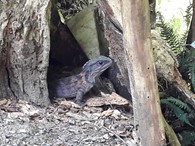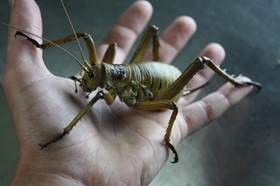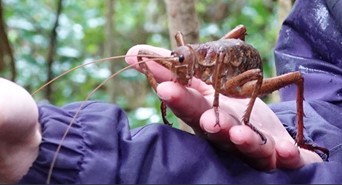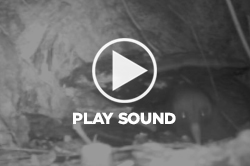Tuatara / Skinks / Geckos / Wetapunga
Since 2009, a number of native gecko and skink translocations to Motuihe Island have taken place. Moko and copper skinks already have an existing population on the island. As the bush regenerates develops, the populations and spread of these will increase.
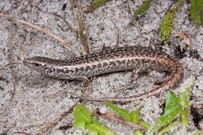 Photo: Acknowledgement to Dylan Van Winkel
Photo: Acknowledgement to Dylan Van Winkel
Shore Skinks (Oligosoma smithi): 69 were translocated from Tawharanui Peninsular in 2009. They live in sand dunes, often found around or under driftwood at high tide and other debris and active during the day. They feed on sand hoppers or small insects found around the shoreline. Skinks are characterised by a smooth shiny skin with overlapping scales, narrow head, smooth narrow toes and small round pupils with movable lids. They shed skin in pieces rather than whole. Rather than laying eggs, gravid females give birth to live young. (DOC Media Release)
Tuatara (Sphenodon punctatus): 60 were translocated from Lady Alice Island, Northland in 2012. Rare, medium-sized reptiles found only in New Zealand. They are the last survivors of an order of reptiles that thrived in the age of the dinosaurs. Their diet mainly consists of invertebrates such as beetles, weta, worms, millipedes and spiders. They come in a variety of colours from olive green, charcoal to reddish brown. They shed their skin annually. (DOC Media Release)
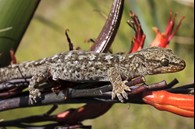 Photo: Acknowledgement to Dylan Van Winkel
Photo: Acknowledgement to Dylan Van Winkel
Common - Raukawa Gecko (Woodworthia maculata): 60 were translocated from Otata Island, part of the Noises Islands in Auckland's Hauraki Gulf in 2013. Grey or brown colour, often with variable markings that may involve bands, stripes, blotches or chevrons. Rostral scale on tip of snout does contact nostrils (see diagram). Toes have greatly expanded toe pads. Nocturnal, semi-arboreal. Inhabits forest, scrub, grassland and beaches. Forages near the high-tide line. Often found in rock crevices and under rocks on boulder beaches.
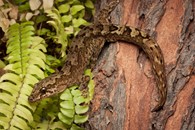 Photo: Acknowledgement to Dylan Van Winkel
Photo: Acknowledgement to Dylan Van Winkel
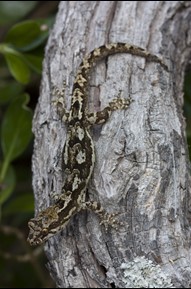 Photo: Acknowledgement to Dylan Van Winkel
Photo: Acknowledgement to Dylan Van Winkel
Pacific Gecko (Dactylocnemis pacificus): 114 were translocated from Tarahiki Island (Shag Island) in Auckland's Hauraki Gulf in 2014. Grey or brown colour with variable markings that may involve bands, stripes, blotches or chevrons. Markings often bright and distinctive. Occasionally have mustard-yellow patch across nape. Rostral scale on tip of snout in broad contact with nostril (see diagram). Expanded toe pads with long claw. Nocturnal. Inhabits forest, scrub (kanuka), grassland and rocky coastlines.
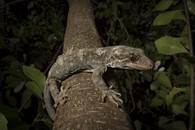 Photo: Acknowledgement to Dylan Van Winkel
Photo: Acknowledgement to Dylan Van Winkel
Duvaucel Gecko (Hoplodactylus duvaucelii): 100 were translocated from Stanley Island (Mercury Islands) off the Coromandel Peninsular in 2014. Large robust gecko; mainly grey with olive-green or dark brown blotches. Large green or brown eyes. Lower surface uniform or speckled. Toes have expanded toe pads with long claw. Nocturnal, semi-arboreal. Lives in forest and scrub vegetation. Often found in rock crevices and close to the shoreline. Forages in trees and on the ground. May bite when handled. (DOC Media Release)
Photo: Acknowledgement to Ben Goodwin (Auckland Zoo)
Little Barrier Giant Wētā or Wētāpunga: (Deinacrida heteracantha): Approximately 1500 are scheduled to be translocated to Motuihe Island mid to late 2020. These have been bred by Auckland Zoo staff. Survived only at Little Barrier initially and endemic to New Zealand. Female wetapunga are larger than males and can reach a weight of 35 grams. Moulting is necessary for them to grow in size and can take up to 11 moults before maturity. It can take up to two years for them to become adults. They commence breeding 1-2 months after maturity. Females will lay eggs throughout adult life, generally producing 100-300 eggs. Large flightless weta feed mainly at night. They feed on fresh leaves and prefer native plants with large leaves such as karaka, karamu, māmāngi, māhoe, and kohekohe.
Wetapunga Release 2 December 2020
Auckland Zoo Wetapunga Full Video -Acknowledgement to Auckland Zoo
TVNZ link. Acknowledgement TVNZ
Radio NZ link: Acknowledgement RNZ
Short Video below courtesy of Auckland Zoo
Click on images for larger format
